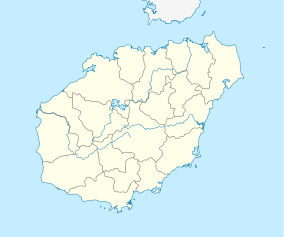Nandu River Iron Bridge
| Nandu River Iron Bridge 海口南渡江铁桥 | |
|---|---|
|
A view from the eastern shore of the Nandu River, just north of the bridge | |
| Coordinates | 19°58′53″N 110°24′20″E / 19.981372°N 110.405486°ECoordinates: 19°58′53″N 110°24′20″E / 19.981372°N 110.405486°E |
| Crosses | Nandu River |
| Locale | Haikou, Hainan, China |
| Other name(s) | Lu Palace Bridge (original Japanese name) |
| Characteristics | |
| Design | Truss |
| Material | Steel |
| Total length | 785.34 metres |
| Width | 6.8 metres |
| Load limit | 20 tons |
| Design life | 20 years |
| History | |
| Fabrication by | Kaohsiung Shipbuilding Production and Installation |
| Construction begin | March 26, 1940 (approval to begin design and construction)[1] |
| Opened | 1942 |
| Collapsed | 2000 |
| Closed | 1982 |
 Nandu River Iron Bridge Location in Hainan | |
The Nandu River Iron Bridge (Chinese: 海口南渡江铁桥), also known as the Devil's Iron Bridge, Old Iron Bridge, and originally the Lu Palace Bridge (吕宫桥), is a partially collapsed, steel truss bridge over the Nandu River, in the north of Hainan Province, China. Opened to traffic in 1942, it was Hainan's first bridge over the Nandu River.[2]
History
The bridge was built by the Imperial Japanese Army during the Second Sino-Japanese War to provide access to the land west of the river. On March 26, 1940, approval was given to begin design and construction.[1] The responsibility for the bridge's construction was given to the Japanese company Shimizu Group Contracting, with the steel frames built by Taiwan's Kaohsiung Shipbuilding Production and Installation.[3]
The bridge is 785.34 metres (2,576.6 ft) long, 6.8 metres (22 ft) wide, and has a concrete deck. A cylindrical, concrete guard house remains at the eastern end with horizontal openings. The bridge was designed for a maximum useful lifespan of 20 years, and could carry 20 tons. After liberation, the bridge entered civilian service with a 10-ton load limit and one-way traffic only.[3]
In 1984, the Qiongzhou Bridge was constructed approximately 5 kilometres (3.1 mi) to the north (downstream). As the Nandu River Iron Bridge deteriorated and became dangerous, it was closed to traffic and preserved as a monument.[4]

Safety concerns
In October 2000, flooding caused the collapse of the western part of the bridge,[5] leaving three trusses. These trusses are corroded, with many of the struts heavily pitted or completely rusted through. Concerns over the potential for collapse of the remains have prompted discussions over whether it should be dismantled. Local residents and others wish to preserve it as a historical monument.[6][7][8]
Today, the bridge attracts such visitors as photographers, tourists, couples using the site as a backdrop for wedding photo shoots, and on September 18 each year, people gather to pay tribute.[9]

References
- 1 2 "海南岛"母亲河"上的南渡江铁桥". Hi.chinanews.com. Retrieved 2013-04-07.
- ↑ "海口南渡江铁桥". Hq.xinhuanet.com. Retrieved 2013-04-04.
Google translate.
- 1 2 "海口南渡江铁桥". Hq.xinhuanet.com. Retrieved 2013-04-07.
- ↑ "日本侵略中国的历史见证铁桥". Nanhai.hinews.cn. 2012-09-19. Retrieved 2013-04-04.
- ↑ "人民网地方联报网". Unn.com.cn. Retrieved 2013-04-04.
- ↑ "存废之争不断,海口南渡江铁桥安全隐患严重". News.0898.net. Retrieved 2013-04-04.
- ↑ "南渡江铁桥--海口市首届十大旅游名村评选活动". Zt.haikoutour.gov.cn. Retrieved 2013-04-04.
- ↑ "国家文物局局长建言南渡江铁桥应报"国保"". Wchol.com. 2009-07-21. Retrieved 2013-04-04.
- ↑ http://news.0898.net/2009/05/25/458381.html
External links
| Wikimedia Commons has media related to Nandu River Iron Bridge. |
